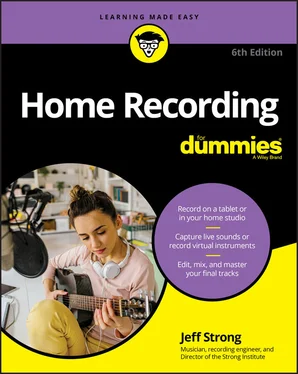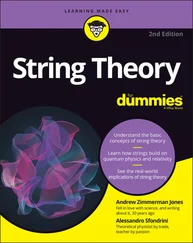 Peering into the process of recording
Peering into the process of recording
 Making sense of mixing and mastering
Making sense of mixing and mastering
 Finishing up your project
Finishing up your project
Audio recording is a fun and exciting activity. Being able to put down your musical ideas and craft them into an album is nearly every musician’s dream. The only problem is the learning curve that comes with being able to record your music at home; most musicians would rather spend their time and energy making music.
In this chapter, I help you get a handle on the basics of home recording and show you what’s involved in the process. You discover the basic components of a recording studio and find out what gear you need to buy first. In addition, you explore the multitracking process and find out what’s involved in mixing your tracks. You move on to exploring mastering and finding ways to share your music with your listeners.
Examining the Anatomy of a Home Studio
Whether it’s a free phone app or a million-dollar commercial facility, all audio recording studios contain the same basic components. Understanding these basic components is an area where many people get lost and one about which I receive the most email. As you glimpse the recording world, you’ll inevitably think that recording your own music will cost way too much and be way too complicated. Well, it can be. But it can also be pretty simple and cost-efficient. In the following sections, I present a list of audio-recording essentials and offer insight into cost-saving and efficient systems that you can find on the market.
Exploring the recording essentials
To take the mystery out of recording gear, here are the essentials that you need to know:
Sound source: The sound source is your voice, your guitar, your ukulele, or any other of the many sound makers in existence. As a musician, you probably have at least one of these at your disposal right now.
Input device: Input devices are what you use to convert your sound into an electrical impulse that can then be recorded. Here are the four basic types of input devices:Instruments: Your electric guitar, bass, synthesizer, and drum machines are typical instruments you plug into the mixer. These instruments constitute most of the input devices that you use in your studio. The synthesizer and drum machine can plug directly into your mixer or recorder, whereas your electric guitar and bass need a direct box (or its equivalent, such as an instrument or Hi-Z input in your audio interface) to plug into first. A direct box is an intermediary device that allows you to plug your guitar directly into the mixer. Chapter 9explores instruments and their connections to your system.Microphones: A microphone (or mic) enables you to record the sound of a voice or an acoustic instrument that you can’t plug directly into the recorder. A microphone converts sound waves into electrical energy that can be understood by the recorder. I detail several types of microphones in Chapter 6.Sound modules: Sound modules are special kinds of synthesizers and/or drum machines. What makes a sound module different from a regular synthesizer or drum machine is that a sound module contains no triggers or keys that you can play. Instead, sound modules are controlled externally by another synthesizer’s keyboard or by a Musical Instrument Digital Interface (MIDI) controller (a specialized box designed to control MIDI instruments). Sound modules have MIDI ports (MIDI jacks) that enable you to connect them to other equipment. Chapter 11digs into the details about sound modules.Software synthesizers: Software synthesizers (also known as softsynths ) are software programs that don’t need hardware MIDI connections because the sound modules are stored on your computer’s hard drive. Depending on what your sound source is, it may also be an input device. For example, an electric guitar has pickups that allow you to plug it directly into a mixer input without having to use a microphone. On the other hand, your voice can’t accept a cord, so you need to use a mic to turn your singing into an electrical impulse that can be picked up by your mixer or equivalent device. You can find out more about input devices in Chapter 9.
Mixer: You use a mixer to send the electrical signal of your input device into your recorder and to route signals in a variety of ways. Traditionally, a mixer serves the following purposes:Routing your signals into your recorder: This allows you to set the proper level for each input device so that it’s recorded with the best possible sound. Chapter 4explores the different mixer-type devices for this purpose.Blending (mixing) your individual tracks into a stereo pair (the left and right tracks of your stereo mix) or surround sound channels: This role of the mixer is where your vision as a music producer takes center stage and where you can turn raw tracks into a polished piece of music. Chapter 16explores this use of a mixer.
Recorder: The recorder stores your audio data. For most home recordists, the recorder is digital. You can find out more about the different types of recorders in the next section of this chapter.
Signal processors: Most of the time, you have to tweak your recorded tracks. Signal processors give you the power to do this. Signal processors can be divided into the following basic categories:Equalizers: Equalizers let you adjust the frequency balance of your tracks. This is important for making your instruments sound as clear as possible and for getting all your tracks to blend well.Dynamics processors: Dynamics processors are used to control the balance between the softest and loudest parts of your tracks. They have many uses in the studio to help you make your tracks sit well together and to keep from overloading your system. Chapters 9, 19, and 22explore ways to use dynamics processors in your music.Effects processors: Effects processors allow you to change your tracks in a variety of ways, such as to create a more realistic sound or unusual effects. Typical effects processors include reverb, delay, chorus, and pitch shifting. You can find out more about these processors in Chapter 19.
Monitors: Monitors, such as quality headphones or speakers, enable you to hear the quality of your recording and mixing. Monitors come in three basic designs:Headphones: Headphones come in an astonishing variety. Some are good for listening to music, while others are good for recording and mixing music. Most home recordists start with headphones because they typically cost a lot less than speakers and serve the double duty of allowing you to hear yourself while you record and allowing you to hear the mix when all your tracks are done.Passive: Passive monitors are like your stereo speakers in that you also need some sort of amplifier to run them. A ton of options are available with prices from around $100. Just remember that if you go this route, you need to budget money for an amp, which can run a few hundred dollars or more.Active: Active monitors have an integrated amplifier in each speaker cabinet. Having a built-in amp has its advantages, including just the right amount of power for the speakers and short runs of wire from the amp itself to the speakers (this is kind of a tweaky area that some people claim produces a better sound). You can find quite a few active monitors on the market starting at just a couple hundred dollars.
Checking out recording system types
Читать дальше

 Peering into the process of recording
Peering into the process of recording










